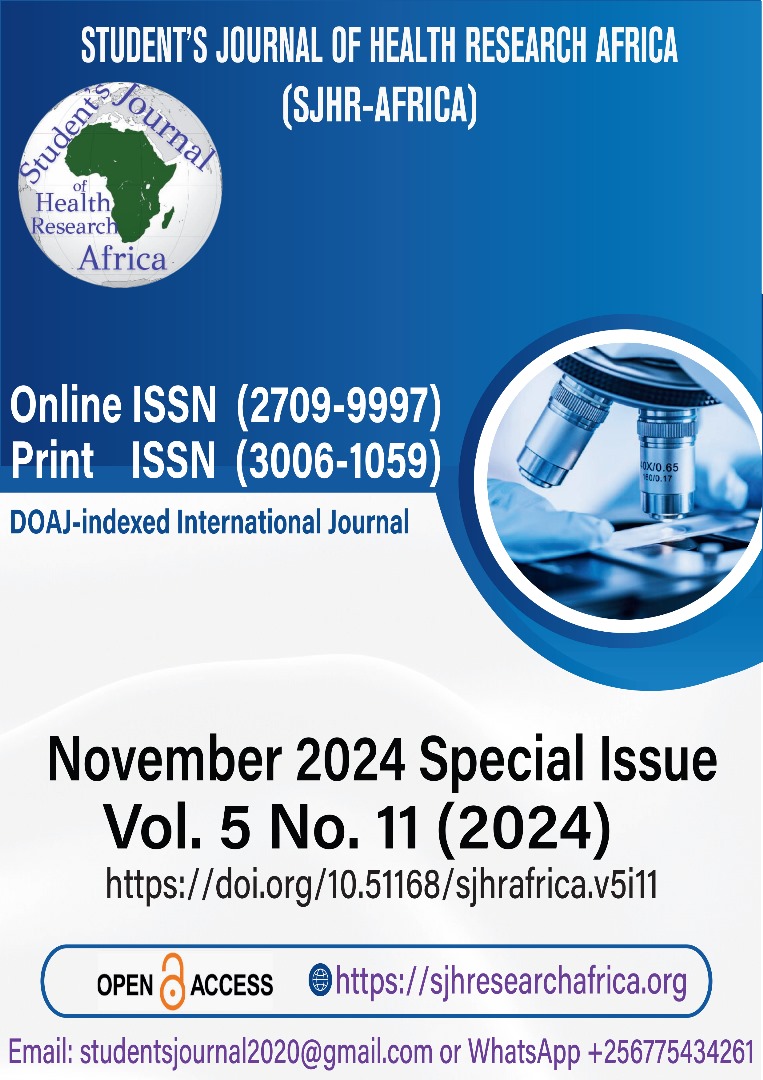A STUDY OF PROGNOSTIC FACTORS OF ACUTE LIMB ISCHEMIA
DOI:
https://doi.org/10.51168/sjhrafrica.v5i11.1848Keywords:
Acute limb ischemia, thromboembolectomy, Rutherford classification, limb salvageAbstract
Background:
Acute limb ischemia (ALI) is a sudden reduction in limb perfusion that threatens limb viability and requires urgent intervention.
Objectives: To evaluate prognostic factors influencing outcomes in patients with ALI undergoing surgical revascularization.
Materials and Methods:
This prospective study was conducted over two years at JNMCH, AMU, Aligarh, involving 28 patients diagnosed with ALI. Clinical data, risk factors, etiology, Rutherford classification, surgical procedures, and postoperative outcomes were recorded and analyzed.
Results:
The majority of patients were male (85.7%) with a mean age of 39.5 years. Thromboembolism (67.9%) was the most common cause, and Rutherford class IIa was the most frequent presentation (64.3%). Risk factors included diabetes (46.4%), smoking (42.9%), and hypertension (39.3%). Limb salvage was achieved in 85.7% of cases, while 14.3% required amputation. Early intervention was associated with better functional outcomes.
Conclusion:
Prompt diagnosis and timely surgical management significantly improve limb salvage in ALI. Identification and control of modifiable risk factors are essential to prevent disease progression and reduce amputation rates.
References
Dormandy JA, Heeck L, Vig S. Acute limb ischemia. Semin Vasc Surg. 1999;12(2):148–53.
Howard DP, Banerjee A, Fairhead JF, Handa A, Silver LE, Rothwell PM. Population-based study of incidence, risk factors, outcome, and prognosis of acute peripheral arterial events: implications for prevention. Circulation. 2015;132(19):1805–15. doi:10.1161/CIRCULATIONAHA.115.015354
Earnshaw JJ, Whitman B, Foy C. National Audit of Thrombolysis for Acute Leg Ischaemia (NATALI): clinical factors associated with early outcome. Eur J Vasc Endovasc Surg. 2004;27(2):172–7. doi:10.1016/j.ejvs.2003.12.008
Blaisdell FW. The pathophysiology of skeletal muscle ischemia and the reperfusion syndrome: a review. Cardiovasc Surg. 2002;10(6):620–30. doi:10.1016/S0967-2109(02)00188-5
Rutherford RB, Baker JD, Ernst C, et al. Recommended standards for reports dealing with lower extremity ischemia: revised version. J Vasc Surg. 1997;26(3):517–38. doi:10.1016/S0741-5214(97)70045-4
Fogarty TJ, Cranley JJ, Krause RJ, Hafner CD, Strasser ES. A method for extraction of arterial emboli and thrombi. Surg Gynecol Obstet. 1963;116:241–4.
Shalhub S, Starnes BW, Tran NT. Outcome after management of acute limb ischemia: a contemporary single-institution experience. J Vasc Surg. 2011;53(1):173–9. doi:10.1016/j.jvs.2010.07.003
Fowkes FG, Rudan D, Rudan I, et al. Comparison of global estimates of prevalence and risk factors for peripheral artery disease in 2000 and 2010: a systematic review and analysis. Lancet. 2013;382(9901):1329–40. doi:10.1016/S0140-6736(13)61249-0
Warkentin TE. Heparin-induced thrombocytopenia. Curr Opin Crit Care. 2015;21(6):576–85. doi:10.1097/MCC.0000000000000250
Kodama K, Okamoto K, Yamada T, et al. Acute limb ischemia in nephrotic syndrome: a case report and literature review. Intern Med. 2016;55(6):689–93. doi:10.2169/internalmedicine.55.5277
Nordestgaard BG, Chapman MJ, Ray K, et al. Lipoprotein(a) as a cardiovascular risk factor: current status. Eur Heart J. 2010;31(23):2844–53. doi:10.1093/eurheartj/ehq386
Kostner GM, Gavish D, Leopold B, et al. Heterogeneity of human apolipoprotein (a). J Biol Chem. 1985;260(10):6207–13.
Liao CJ, Luo CM, Chen WZ, Jiang QW, Lin XM, Lin YQ. Analysis of 154 patients with acute lower limb ischemia treated surgically. Chin J Traumatol. 2008;11(4):233–6.
Turel MK, Dubey M, Verma A, Gupta S. Acute limb ischemia in a tertiary care centre in India: a prospective observational study. Indian J Vasc Endovasc Surg. 2008;25(3):77–82.
Kuoppala M, Karkola P, Riekkinen H, Biancari F. Thrombolysis for lower limb ischemia is associated with a high risk of amputation and death during follow-up. J Thromb Thrombolysis. 2008;25(3):267–72.
Yangni-Angate H, Koffi RH, Yayehd K, N’Guetta R, Diop IB, Adoubi A. Acute non-traumatic limb ischemia: management and prognosis in a developing country. Med Trop (Mars). 2006;66(6):590–2.
Downloads
Published
How to Cite
Issue
Section
License
Copyright (c) 2024 Azam Haseen, Deepak Kumar, Ilmul Huda, Nirmal Paswan

This work is licensed under a Creative Commons Attribution-NonCommercial-NoDerivatives 4.0 International License.






















